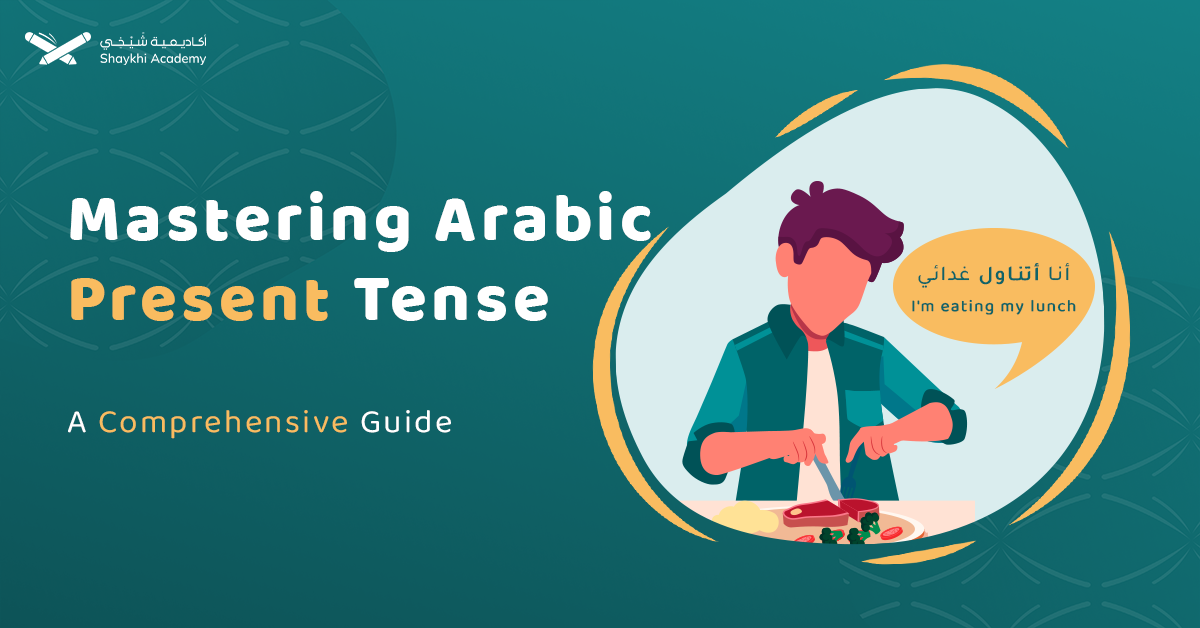Present Tense (اِلْفِعْلُ الْمُضارِعُ) indicates activities that take place in the present time or expresses continuing actions. In some cases, it refers to actions that are going to happen in the future.
Unlike the past tense, which reflects accomplished actions, the present tense specifies actions that are in progress, regular routine, or actions that are expected to occur. Its multifaceted usages serve different aspects in the Arabic sentence syntaxes.
In this article, we will deal with many different aspects of the Arabic Present Tense. Keep reading.
Present Tense in Arabic
The present tense in Arabic (mudāri‘ / المضارع) is a flexible tense used to indicate a variety of concepts in connection with the present time.
In the following lines, we will shed light on how it works. Go no further.
The Meaning of the Present Tense in Arabic
Present Tense in Arabic describes actions that are taking place at the moment or indicates routine activities that occur frequently. It can be used, in some cases, to refer to future actions that are going to happen.
Ex:
Heba drank a glass of milk.
تَشرَبُ هبهُ كوبًا من اللبنِ كل يوم
Tashirabo Heba kobin men al-labn kol yaum.
Present Tense Verb Roots
The perception of the verb root with its trilateral format is of a pertinent significance; it is the main key for comprehending the Arabic present tense and understanding all other tenses. Gaining further knowledge about this topic is a crucial grammatical matter, check Shaykhi Academy’s Learn Arabic Online Course for more details.
All verbs in the Arabic language are measured on a phonological scale, its syllables should be vocally identical to the verb root phonetic rhythm (فَعَلَ) which consists of three phonetic syllables [ف- ع- ل]. So the verb (drank / شرب) will be measured on the phonetic rhythm of the word root (فعل):
ف ع ل
ش ر ب
The first letter (ف) stands for (ش) The 2nd letter (ع) stands for (ر) The third letter (ل) stands for (ب)
Present Tense Verb Pattern
All present verbs begin with one of the following letters: (أ – ن – ي – ت), added as a prefix to the verb root, such letters are called the present shaping letters (حروف الْمُضَارَعَة).
In the Arabic language, The conjugated verb pattern with the third person singular masculine is the most familiar pattern to indicate all Arabic tenses.
Examples:
يشرب [He drinks] يسبح [He swims]
But you have to bear in mind that it is just one conjugation for the verb. There are many other conjugations according to the number and the gender of the sentence subject.
Similarly, the verb root is always in the pattern of the third person, singular masculine. Ex, لعب [He played], The verb root is a basic foundation for building the sentence syntaxes and expressing actions in the Arabic language.
Present Tense Forms
The Arabic present tense Forms are consisting of 14 forms. These forms are established according to different determinants such as person, gender and number of the sentence subject pronoun. For more information, visit the page of Shaykhi Academy’s General Arabic Course.
The sentence verb must cope with its subject in number, person and gender, so the shape of a present tense verb should be conjugated appropriately with the subject of the sentence. Here are more details.
Present Tense Formation in Arabic
It is formed by transmitting the past verb or the verb root onto the present formula by adding one of the following prefixes (أ – ن- ي- ت).
● Alf with hamza (أ) is used with the first person singular pronoun (أنا).
Example:
أَشْرَبُ اللبن
I am drinking milk.
A’shra’bo el labin.
● El-noon (ن) is used with the first person plural pronoun (نحن).
Example:
نَشرَبُ اللبن
We are drinking milk.
Na’shr’bo El labin.
● Yaa (ي) is used with the third person masculine singular or dual or plural pronouns (/هو/هما/هم).
Example:
يَشرَبُ على اللبن
Ali is drinking milk.
Ya’shra’bo Ali el labin.
● Taa (ت) is used with the second person pronouns (أنت – أنتي – أنتما – أنتم – أنتن). It is used with all genders and numbers of the second person. It is also used with the third person feminine singular or dual or plural (هى/هما/هنّ).
Examples:
أنت تَشرَبُ اللبن
You are drinking milk.
Anta ta’shra’bo el labin.
هي تَشرَب اللبن
She is drinking milk.
Haya ta’shra’b el Labin.
It is worth mentioning that other suffixes may be removed or added to the verb root or the past verb form according to the appropriate conjugation of the person, number, and gender of the main sentence subject pronoun who is the doer of the action.
The following chart summarizes this point
| Past ماضي | Present مضارع |
| لَعِبتُ I played | ألعبُ I play |
| لَعبنا We played | نَلعبُ We play |
| لَعَبَ He played | يَلعبُ He plays |
| لَعَبتَ She played | تَلعبُ She plays |
| لَعِبتْ You played | تلعبُ You play |
| لَعَبوا They played | يلعبون They play |
Present Tense Usages
The present tense is used to state the following concepts in the present time:
1. Frequent actions:
It refers to habitual actions and regular events that happen frequently in the present time.
Ex:
أنا أُصَلي كلَ صباحٍ
Ana o’sa’lee koll sa’ba’h.
I do prayers every morning.
2. Common Facts
It refers to overall truths and familiar facts in all aspects of the human daily life.
Ex:
أنا أَعِيشُ في مصرِ
Ana a’3sho fe Masr.
I live in Egypt.
3. Future plans
It refers to planned activities that are going to happen in the future. There must be additional words in the context reflecting the future sense.
Ex:
أُسافرُ إلى لندن الشَهرُ القادم
Osa’afiro Ela London El-sha’haro El-qadim.
I am going to travel to London next month.
Present Tense Conjugation
The total number of the verb
conjugations obtainable from a word root are approximately 14 forms. These various forms are based on various elements related to the sentence syntaxes.
The prefix or suffix that is added to the present tense verb is mainly specified according to the person, number, and gender of the subject pronoun (the action doer).
This process is called verb conjugations. It indicates how to conjugate a sentence’s main verb with the sentence subject pronoun.
Present Tense Conjugations Chart
Look carefully at the following timetable. Pay much attention to the present verb conjugations with the various subject pronouns.
| Arabic Pronounsضمائر الفاعل العربية | English Equivalent Pronounsضمائر الفاعل الانجليزية | Description الوصف | Conjugationsالتصريفات |
| أنا | I | First Person Singular | أنظفُ / Ao’na’thefo |
| نحن | We | First Person Plural | ننظفُ / No’na’thefo |
| أنت | You | 2nd Person Singular Masculine | تنظفُ / To’na’thefo |
| أنتِ | You | 2nd Person Singular Feminine | تنظفين / To’na’thefen |
| أنتما | You | 2nd Person Dual Masculine | تنظفان / To’na’thefan |
| أنتما | You | 2nd Person Dual Feminine | تنظفان / To’na’thefan |
| أنتم | You | 2nd Person Plural Masculine | تنظفون / To’na’thefoon |
| أنتن | You | 2nd Person Plural Feminine | تنظفنَ /To’na’thefin |
| هو | He | Third Person Singular Masculine | ينظفُ / Yo’na’thef |
| هي | She | Third Person Singular Feminine | تنظفُ / To’na’thef |
| هما | They | Third Person Dual Masculine | ينظفان / Yo’na’thefan |
| هما | They | Third Person Dual Feminine | تنظفان / To’na’thefan |
| هم | They | Third Person Plural Masculine | ينظفون / Yo’na’thefoon |
| هن | They | Third Person Plural Feminine | يُنظفْن / Yo’na’thefin |
Examples of Present Tense Conjugations
Look carefully at the following examples of present tense conjugations. Pay much attention to the description between brackets.
(First Person Singular)
1. I am writing the lesson.
( أَكْتُبُ الدرس)
(First Person Plural)
2. We are writing the lesson.
( نَكْتُبُ الدرس)
(Second Person Singular Masculine)
3. You are writing the lesson.
( تَكْتُبُ الدرس)
(Second Person Singular Feminine)
4. You are writing the lesson.
( تَكْتُبِينَ الدرس)
(Second Person Dual Masculine)
5. You are writing the lesson.
( تَكْتُبَانِ الدرس)
(Second Person Dual Feminine)
6. You are writing the lesson.
(تَكْتُبَانِ الدرس)
(Second Person Plural Masculine)
7. You are writing the lesson.
( تَكْتُبَونَ الدرس)
(Second Person Plural Feminine)
8. You are writing the lesson.
( تَكْتُبْنَ الدرس)
(Third Person Singular Masculine)
9. He is writing the lesson.
( يَكْتُبُ الدرس)
(Third Person Singular Feminine)
10. She is writing the lesson.
( تَكْتُبُ الدرس)
(Third Person Dual Masculine)
11. They are writing the lesson.
( يَكْتُبَانِ الدرس)
(Third Person Dual Feminine)
12. They are writing the lesson.
( تَكْتُبَانِ الدرس)
(Third Person Plural Masculine)
13. They are writing the lesson.
( يَكْتُبُونَ الدرس)
(Third Person Plural Feminine)
14. They are writing the lesson.
(يكتَبْنَ الدرس)
Significant Notes:
● There is just one present tense in the Arabic language. It stands for the four kinds of presents in the English Language and indicates all other presents in any other language.
Using specific Arabic words or syntaxes in the Arabic sentence helps to indicate which kind of present is intended and equals this present.
● El Hamza (ء) is placed on the top of the letter alf (ا) of the Arabic present verb to have this shape (أ). This is to distinguish the present tense verb from the imperative tense verb which is drawn without Hamza (ء).
Present Tense Negation
Here are a schedule of the negative form of the Arabic present tense for the verb (like /يحب):-
| Pronouns description نوع الضمير | Negative form صيغة النفي | Translation |
| 1. First Person Singular | ُلا أُحب | I do not like |
| 2. First Person Plural | ُلا نحب | We do not like |
| 3. Second Person Singular Masculine | لا تُحبُ | You do not like |
| 4. Second Person Singular Feminine | لا تُحْبَان | You do not like |
| 5. Second Person Dual Masculine | لا تُحْبَان | You do not like |
| 6. Second Person Dual Feminine | لا تُحبُونَ | You do not like |
| 7. Second Person Plural Masculine | لا تُحْبِنن | You do not like |
| 8. Second Person Plural Feminine | لا تُحِبِينَ | You do not like |
| 9. Third Person Singular Masculine | لا يُحبُ | He does not like |
| 10. Third Person Singular Feminine | لا تٌحبُ | She does not like |
| 11. Third Person Dual Masculine | لا يُحْبَان | They do not like |
| 12. Third Person Dual Feminine | لا تُحْبَان | They do not like |
| 13. Third Person Plural Masculine | لا يُحبونَ | They do not like |
| 14. Third Person Plural Feminine | لا يُحبْبنَ | They do not like |
Examples:
1. Soha does not like milk.
لا تُحبُ سها اللبن.
Soha la to’heb el labin.
2. We do not like apples.
نحنُ لا نُحبُ التٌفْاحَ.
Nah’no la no’heb el labin.
3. The lion doesn’t live in the sea.
لا يَعيشُ الأَسَدُ في البَحْرِ.
La Ya’3esho al-asid fee el-bahr.
4.The women don’t go to the market on Friday.
لا يَذهبنْ النسوةُ إلى السْوقِ يومْ الجُمعَة.
La ya’zhabin an-niswa ela as-sook yaum el-goma3a
Arabic Present Tense Chart Versus Other Tenses
The following schedule compares the Arabic present tense with other tenses. All scheduled verbs are in the form of the third person singular masculine.
| المضارع / Present | الماضي / Past | المستقبل/ Future | الأمر / Command |
| يفهم Understand | فهم | سيفهم | اِفهم |
| يكسر Break | كسر | سيكسر | اِكسر |
| يطبخ Cook | طبخ | سيطبخ | اِطبخ |
| ينصح Advise | نصح | سينصح | اِنصح |
| يجلس Sit dawn | جلس | سيجلس | اِجلس |
| يبيع Sell | باع | سيبيع | بِع |
| يفوز Win | فاز | سيفوز | فز |
| يتسلق Climb | تَسلَّقَ | سيتسلق | تَسلِق |
| يمشي Walk | مشى | سيمشي | اِمشي |
| يقف Stop | وقف | سيقف | قف |
Start Your fruitful Journey of Learning Arabic Present Tense With Shaykhi Academy
Shaykhi Academy provides you with enhanced grammatical theories about the affluence and abundance of the Arabic language tenses.
Shaykhi Academy’s Online Fusha Arabic Course To Learn Modern Standard Arabic is a suitable course for all learners. It covers essential language syntaxes and deals with critical grammatical thoughts.
Shaykhi Academy’s all-inclusive curriculum offers immersive educational experiences tailored in a deepened way to capture the learners’ attention.
Shaykhi Academy’s Online Fusha Arabic Course To Learn Modern Standard Arabic provides you with exceptional services under the auspices of the experienced tutors Dr. Mahmoud AlAssal and Sh. Luqman ElKasabany.
You have to bear in mind that All Shaykhi Academy staff graduated from Al-azhr Ash-sharif University with long educational experiences in the teaching field. It is a very essential matter that you learn under the aegis of such quality.
Why Shaykhi Academy?
- Expert Native Tutors: Learn from highly qualified native Arabic speakers.
- Flexible Scheduling: Tailor your classes to fit your busy life.
- Affordable Learning: Access top-quality education at a price that suits you.
- Global Access: Study from anywhere in the world.
Explore Our Arabic Courses:
- Noorani Qaida: Build a strong foundation in Quranic Arabic.
- Comprehensive Arabic Courses: Master the Arabic language, from beginner to advanced levels.
- Fusha Arabic Classes: Delve into Modern Standard Arabic, the key to understanding literature, media, and formal communication across the Arab world.
- Quranic Arabic Course: Enhance your connection with the Quran by learning the language in which it was revealed.
Start Your Arabic Journey Today! Whether you’re just starting or looking to deepen your knowledge, Shaykhi Academy is here to support your journey. Book your free trial now and begin your path to Arabic mastery!

Conclusion
Mastering any language is related to a successful acquisition of its tenses. This is done through gaining much grammatical information about the Arabic tenses. Arabic present tense is the most commonly used tense in daily life. Gaining much information about this tense enables you to master the Arabic language.

















































